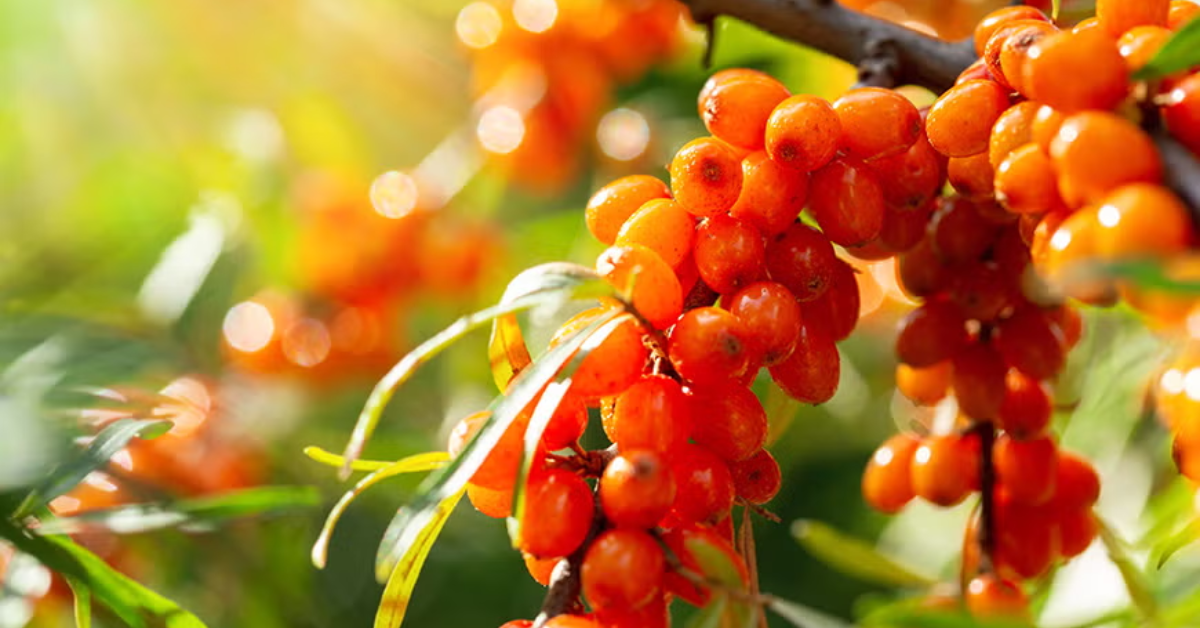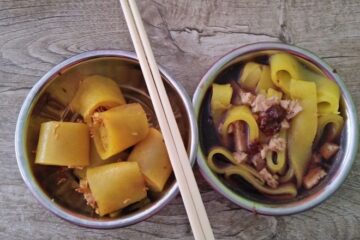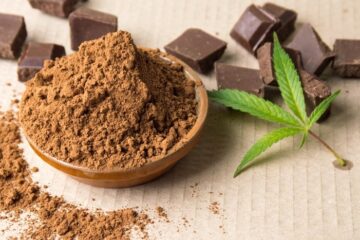Sea Buckthorn (Hippophae spp.) is a spiny, deciduous shrub or small tree native to Nepal’s mid-hill and high-altitude regions. It is a perennial plant that produces orange-red berries rich in nutrients like vitamins, minerals, fatty acids, antioxidants, phytosterols and tocopherols.
The plant has been used in traditional medicine, food, and cosmetics, as well as for soil stabilization and erosion control. Due to its rich nutritional, environmental and economic benefits, the plant is drawing interest among consumers, making berries valuable in rural areas of Nepal.
Currently, there are 9 species of sea buckthorn globally. However, only two species are commonly found in Nepal: Hippophae tibetana and Hippophae salicifolia. Both of these plants are known for resilience, their capability to grow in some of the harshest environmental conditions and their highly nutritious berries.
Where can trekkers can encounter sea buckthorn in Nepal?
Trekkers venturing into Upper Mustang, Dolpo, Manaslu, Manang, and even the Kanchenjunga region are most likely to stumble upon wild Sea Buckthorn bushes. Sea buckthorn can be found growing abundantly along riverbanks, cliff edges, and dry slopes.
- Upper Mustang: Sea buckthorn is a key source of nutrition for locals and trekkers in this remote, desert-like region.
- Dolpo: Trekkers heading towards Shey Phoksundo or remote regions of Dolpo can spot locals collecting berries.
- Manaslu: In the lower regions of Manaslu, especially after crossing the high pass (Larkya La Pass) around Bhimthang, sea buckthorn plants can be seen.
- Langtang: In the higher parts of Langtang Valley, above Kyanjin Gompa, around Langshisha Kharka, these berries can be found.
- Manang: Annapurna region, around Manang Valley, some of the teahouses serve Sea Buckthorn juice as a refreshing and energizing drink for trekkers.
Nutritional, Medicinal and Commercial Benefits
The sea buckthorn berries are a nutritional powerhouse, a nature’s superfruit on the Himalayan trails. They are rich in vitamins A, C and E, fatty acids (especially palmitoleic and oleic acids), antioxidants, phytosterols, tocopherols and minerals. These nutritional values make berries really valuable in improving diets in rural, undernourished areas.
The antioxidant feature of sea buckthorn, rich in Vitamin C, Vitamin E and carotenoids, helps us protect against damage from free radicles and improve our immune system. Likewise, it is a good source of omega-3, 6, 7 and 9 fatty acids, which improves our heart’s function and reduces inflammation. Additionally, the plant also contains minerals like magnesium, potassium and zinc, and amino acids.
Not just the berries but even the leaves of this plant are useful. In fact, evidence can be found, scripted in ancient history dating back to the 8th century, which states over 30 medicinal usages of sea buckthorn. It can be used in treating ulcers, improving digestion, treating skin conditions like burns, and promoting the health of the heart.
Further, it can be used for making jams, juices, and sauces. Sea buckthorn oil extracted from berries and seeds is popularly used in cosmetic and skincare products.
Botanical Characteristics and Sea Buckthorn Cultivation
Sea buckthorn are dioecious shrubs, meaning having the male and female reproductive organs in separate individuals. While only the female plants produce berries, male plants are needed for pollination. For the best yield, an ideal male-to-female pollen ratio is 1:6.
There are two methods for the propagation of sea buckthorn plants.
By seed: It takes about 5-6 years for the plant to mature through the method of propagation. This method promotes biodiversity, but not all seedlings may be female.
By cutting: Through this method, the plant matures faster, about 3-5 years, ensuring that the plants are female and maintain genetic characteristics.
A mature plant can produce berries for 70+ years. A hectare of cultivated land can yield 750 to 1500 kg of berries annually, depending on the plant’s age and environmental factors. In addition, about 18 tons of fuel wood can be produced from a hectare of land.
Gowing Conditions for Sea Buckthorn
Sea buckthorn thrives in the mountains of Nepal. They can withstand extreme temperatures from -40°C to +40°C. Nonetheless, the most optimal temperature for growth is around 20°C, especially during the germination and rapid growth phases. Also, it can grow in dry conditions, even at 250 mm of water/year, but it grows best at around 400 mm/year.
Importance of Sea Buckthorn in the Socio-Economy of Nepal
Sea Buckthorn, also known as ‘Daale chuk’ or ‘Bhuin chuk’, is a wild edible fruit that has been used in Nepal for several purposes.
- Boosts farmer incomes, especially in marginalized hill regions.
- Families can save money for fuelwood and fodder and utilize it for education and health.
- Growing demand for sea buckthorn has created potential for commercial farming.
- Harvesting and processing have created employment for women, landless workers, and postharvest workers, such as sorting, juice, and oil extraction.
Limitations and Challenges
One of the most challenging parts of sea buckthorn cultivation is the long gestation period. Even after using the cutting method, it takes 3-5 years for fruiting.
Other limitations and challenges of sea buckthorn cultivation in Nepal are:
- Only female plants produce berries, so careful selection and a balanced male-female ratio (1:6) is required.
- Best yield entirely depends on moisture, elevation and temperature.
- Initial investment could be expensive, nursery setup, land preparation, and gendered planting requires money and training.
- There is no or limited budget for research and development (R&D) to improve yield.
- Cultivation and harvesting in remote, mountainous terrain makes logistics and transport difficult.
- There is not enough awareness among locals and potential markets about its values and uses.
Final Thoughts
In the remote and rugged terrains of the Himalayas, Sea Buckthorn offers nourishment, healing, and a source of income for locals. This little Himalayan berry is a reminder of how the smallest things can make the biggest difference. Its potential lies in sustainable cultivation, strategic propagation, and usage.
Next time you are on the route, sipping tea, don’t forget to ask for a glass of sea buckthorn juice. It’s not just a drink—it’s a taste of the Himalayas, one that tells a story of resilience, tradition, and change.



